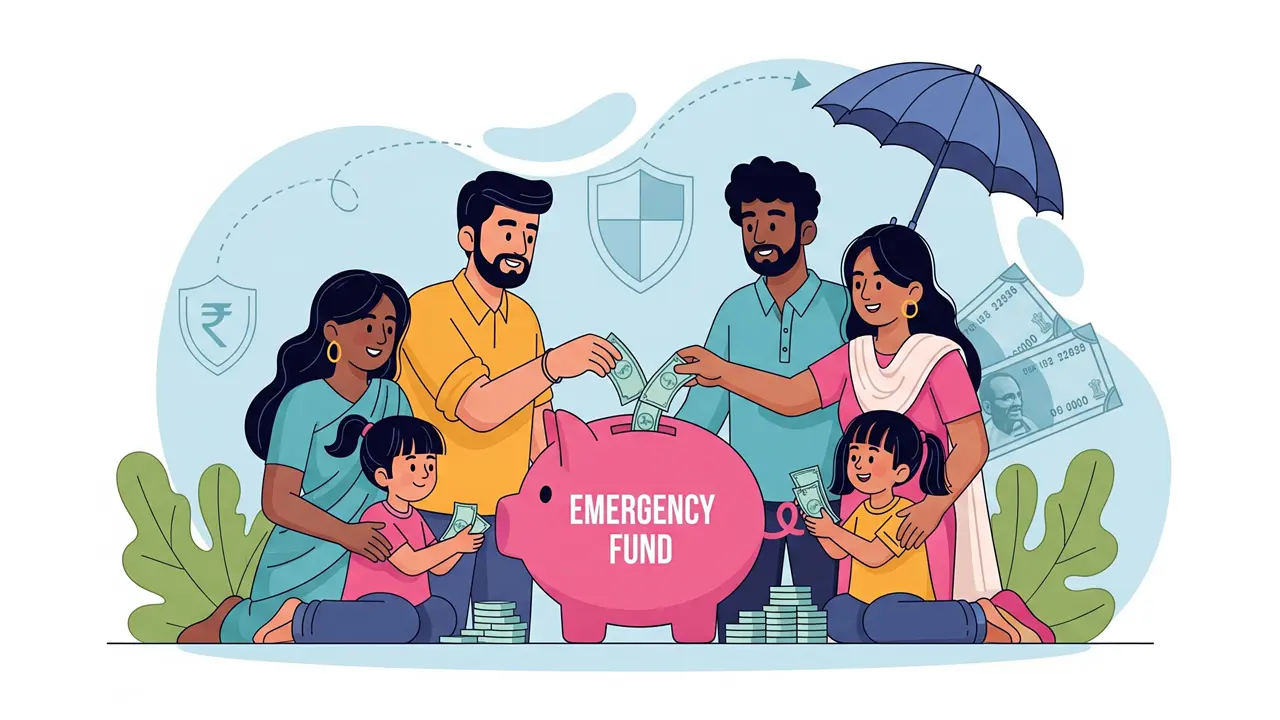Life is full of surprises, and not all of them are pleasant. Unexpected expenses, like medical bills or sudden repairs, can disrupt your financial plans. An emergency fund acts as a safety net, ensuring you’re prepared for such moments. This guide explains why emergency funds are essential and how to build one for lasting financial security.
What Is an Emergency Fund?
An emergency fund is money set aside for unexpected, urgent expenses. These could include medical emergencies, vehicle repairs, or temporary loss of income. Unlike savings for planned goals like vacations, this fund is reserved for unforeseen crises. It’s a financial cushion that keeps you stable during tough times.
Business Loan
Get personal loan up to 5 CR
Home Loan
Get home loan up to 50 lakhs
This fund is separate from your regular savings. It’s meant to be easily accessible, ensuring you can cover sudden costs without stress. For example, a ₹50,000 hospital bill can be paid without borrowing if you have an emergency fund. This separation protects your long-term financial goals.
Why Emergency Funds Are Crucial
Unexpected expenses are inevitable. Without a financial buffer, you might rely on high-interest loans or credit cards. An emergency fund prevents this, offering peace of mind and financial independence. It ensures you’re ready for life’s uncertainties.
Financial security is about more than just earning money. It’s about being prepared for disruptions, like a sudden job loss or a family emergency. An emergency fund lets you handle these without derailing your budget. It’s a key step toward a stable financial future.
Key Benefits of an Emergency Fund
An emergency fund provides multiple advantages for financial stability. It protects you from debt by covering urgent costs without borrowing. For instance, a ₹20,000 home repair can be managed without a loan if you have a fund. This avoids high interest rates that can strain your finances.
It also offers security during income disruptions. If you face a temporary job loss, an emergency fund can cover essentials like rent and groceries. Additionally, it reduces stress, letting you focus on solving problems rather than worrying about money. These benefits make it a vital part of any financial plan.
How Much Should Your Emergency Fund Be?

Aadhar Pe Loan
Get aadhar loan up to 1 lakhs
Personal Loan
Get personal loan up to 5 lakhs
The size of your emergency fund depends on your expenses. Financial experts suggest saving enough to cover 3 to 6 months of essential costs. For example, if your monthly expenses are ₹25,000, aim for ₹75,000 to ₹1,50,000. This range provides a solid safety net.
For those with variable incomes, like freelancers, a larger fund is wise. Saving for 6 to 12 months of expenses ensures stability during lean periods. Calculate your monthly costs, including rent, food, and utilities, to set a realistic goal. Adjust as your expenses change over time.
Steps to Build an Emergency Fund
Creating an emergency fund takes planning and consistency. Start by assessing your monthly expenses to determine your target. For instance, if you spend ₹20,000 monthly on essentials, aim for ₹60,000 to ₹1,20,000. Break this goal into manageable steps to stay motivated.
Begin with small, regular savings. Even ₹1,000 monthly adds up to ₹12,000 in a year. Consistency is more important than large contributions. Over time, these small amounts build a substantial fund.
Choose a safe, accessible place to keep your fund. A savings account or a liquid investment with quick withdrawal options works well. For example, a savings account with a bank like SBI ensures instant access. Avoid risky investments like stocks, as they can lose value.
Automate your savings to stay disciplined. Set up a monthly transfer to your emergency fund account. This ensures you save before spending on non-essentials. Automation makes saving effortless and consistent.
If possible, reduce non-essential spending to boost your fund. For example, cutting back on dining out by ₹1,500 monthly adds ₹18,000 yearly to your savings. Small sacrifices accelerate your progress. These adjustments keep your goals within reach.
Where to Keep Your Emergency Fund
Your emergency fund should be safe and easy to access. A savings account is a popular choice due to its liquidity. Most banks offer accounts with instant withdrawal options, making them ideal for emergencies. Interest rates may be low, but safety is the priority.
Another option is a liquid investment with quick access. Certain financial products allow withdrawals within a day or two, offering slightly higher returns. Check with your bank for flexible options. Ensure your fund is separate from daily spending accounts to avoid temptation.
Avoid locking your fund in long-term investments. Fixed deposits with long tenures or stocks are risky and hard to access. Choose options that balance safety and availability. This ensures your money is ready when you need it.
Common Mistakes to Avoid
Building an emergency fund can be challenging if you make errors. One mistake is not starting early enough. Delaying savings increases your vulnerability to financial shocks. Even small contributions today make a difference.
Another error is using the fund for non-emergencies. Spending it on wants, like a new gadget, defeats its purpose. Keep the fund strictly for urgent needs. This discipline maintains your financial safety net.
Underestimating your needs is also a pitfall. A small fund may not cover major expenses like hospital bills. Aim for at least 3 months’ expenses to be prepared. Regular reviews help adjust your target as costs change.
Emergency Funds for Different Lifestyles
Your emergency fund should match your lifestyle and income. For a family with monthly expenses of ₹15,000, a fund of ₹45,000 to ₹90,000 is sufficient. This covers essentials like rent and food during emergencies. Urban households with higher costs may need more.
Those with variable incomes, like small business owners, should aim higher. Saving for 6 to 12 months of expenses provides security during income fluctuations. For example, a freelancer spending ₹30,000 monthly should target ₹1,80,000 to ₹3,60,000. Tailor your fund to your unique needs.
Single-income households face higher risks. A larger fund ensures stability if the primary earner faces a setback. Conversely, dual-income families might need less, but 3 months’ expenses is still a safe minimum. Adjust based on your financial responsibilities.
Maintaining Your Emergency Fund
Building an emergency fund is only the first step. Regular maintenance keeps it effective. Review your fund annually to account for changes in expenses. For example, if your rent increases, adjust your savings goal.
If you use your fund, replenish it quickly. After spending ₹10,000 on a repair, resume monthly contributions immediately. This restores your safety net. Consistent effort ensures your fund is always ready.
Avoid dipping into the fund for non-urgent expenses. For example, using it for a festival celebration weakens your security. Treat it as a sacred reserve for true emergencies. This mindset protects your financial stability.
Conclusion
An emergency fund is a cornerstone of financial security. It protects against unexpected expenses, reduces reliance on debt, and offers peace of mind. By starting small, saving consistently, and keeping funds accessible, you can build a reliable safety net. Begin today to ensure you’re prepared for life’s uncertainties.
FAQs
1. What is an emergency fund?
An emergency fund is money saved for unexpected expenses like medical bills or repairs. It’s separate from regular savings and ensures financial stability.
2. How much should I save in an emergency fund?
Aim for 3 to 6 months of essential expenses, like ₹60,000 to ₹1,20,000 for ₹20,000 monthly costs. Adjust based on your lifestyle.
3. Where should I keep my emergency fund?
Use a savings account or liquid investment with quick access. Avoid risky assets like stocks for this fund.
4. How can I build an emergency fund on a tight budget?
Start with small savings, like ₹500 monthly, and cut non-essential spending. Consistency builds a fund over time.
5. What counts as an emergency expense?
Emergencies include urgent costs like medical bills or job loss. Non-essentials like vacations don’t qualify.
